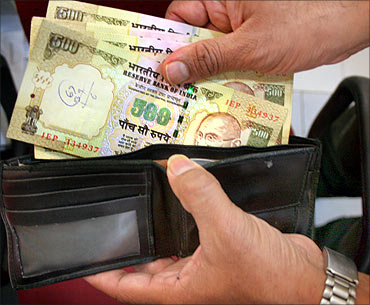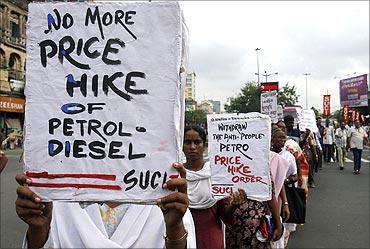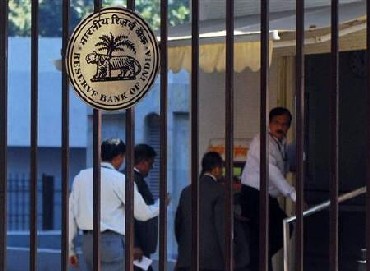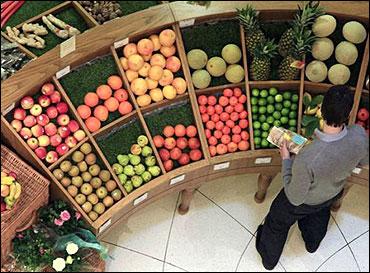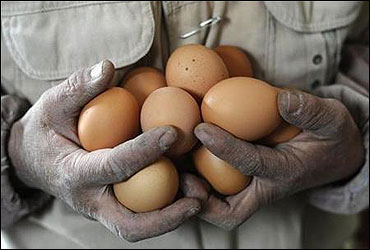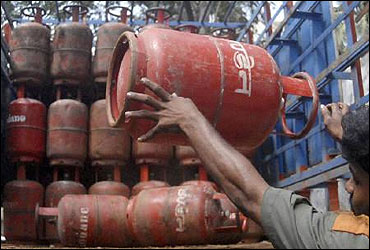 | « Back to article | Print this article |
Indians suffer as inflation continues to rise
Inflation, as measured by the Wholesale Price Index (WPI), stood at 9.06 per cent in May. It was 10.25 per cent in June, 2010.
Meanwhile, as per data released by the government today, the overall inflation figure for April this year has been revised upward to 9.74 per cent from the provisional estimate of 8.66 per cent.Snapping a two-week declining trend, food inflation rose to 8.31 per cent for the week ended July 2 on the back of soaring prices of protein-based items, cereals and vegetables.
Click NEXT to read more
Indians suffer as inflation continues to rise
The higher prices of petroleum goods, according to experts, is adding to supply side constraints.
The index for the fuel and power segment, which has a weight of almost 15 per cent in the WPI basket, stood at 12.85 per cent year-on-year in June. This was up from 12.32 per cent in the previous month.
LPG became 12.17 per cent more expensive on an annual basis, while high speed diesel was up 6.58 per cent. Petrol, whose prices were hiked in April, also became dearer by 30.61 per cent.
Click NEXT to read more
Indians suffer as inflation continues to rise
Inflation in manufactured products has been steadily rising since February this year, when it crossed the 6 per cent mark. It was 7.27 per cent in May.
During the month under review, primary articles witnessed inflation of 12.22 per cent on an annual basis, as against 11.30 per cent in the previous month. Primary articles have a share of around 20 per cent in the overall WPI basket.
Within the primary articles segment, food articles became 8.38 per cent more expensive, while prices of non-food primary articles went up by 18.57 per cent.
Click NEXT to read more
Indians suffer as inflation continues to rise
Experts have said that such action is inevitable and the RBI had also maintained that taming inflation was a priority for the central bank.
However, the latest numbers are in line with the RBI's projection of a high inflation rate in the first half of the fiscal.
In its monetary policy for 2011-12, the central bank had said that continued high prices of global commodities, particularly oil, would continue to drive the rate of price rise.
Click NEXT to read more
Indians suffer as inflation continues to rise
Both the RBI and other experts had also said that inflationary pressure during the next few months would be more from commodity prices, rather than on account of food items, as was the case in 2010.
Headline inflation has been above 8 per cent since January, 2010.
Click NEXT to read more
Indians suffer as inflation continues to rise
Food inflation, as measured by the Wholesale Price Index (WPI), rose by 0.70 percentage points during the week under review vis- -vis the previous week. The rate of price rise in food items stood at 7.61 per cent in the previous week, ended June 25.
As per data released by the government today, fruits and milk became 13.54 per cent and 12.39 per cent costlier, respectively, during the week under review.
Prices of protein-based items like eggs, meat and fish went up by 11.95 per cent annually.Click NEXT to read more
Indians suffer as inflation continues to rise
Among the food items that saw some moderation in prices were pulses (down by 8.46 per cent) and potatoes (down by 2.56 per cent).
The latest numbers on the rate of price rise in food items are the lowest since the week ended June 11, when food inflation stood at 9.13 per cent.
Click NEXT to read more
Indians suffer as inflation continues to rise
Inflation of non-food primary items stood at 15.20 per cent during the week under review, down from 17.69 per cent in the previous week.
Prices of fibres were up almost 34 per cent, while fuel and power became more expensive by 11.89 per cent Y-o-Y. LPG became dearer by 14.58 per cent on an annual basis.
